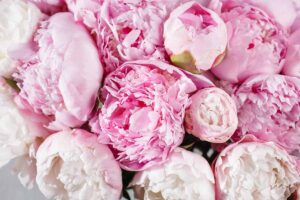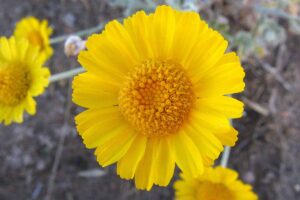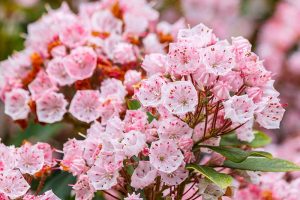Aquilegia viridiflora
Ornamental green columbine, Aquilegia viridiflora, aka green-flowering columbine, is one of about 70 Aquilegia species in the Ranunculaceae, or buttercup family.
The species in this genus and their cultivated varieties are suited to cultivation in USDA Hardiness Zones 3 to 9.

We link to vendors to help you find relevant products. If you buy from one of our links, we may earn a commission.
We call columbine an ephemeral because it makes a brief appearance in the spring, often in the company of other early bloomers, like the crocus, hellebore, and snowdrop.
Our guide to growing columbine contains all you need to know to grow Aquilegia of all types.
In 35 Columbine Flowers for the Spring Garden, we share an exciting array of species and cultivars.
The focus of this article is the green columbine, commonly known as chocolate soldier.
Here’s what we’ll cover:
What You’ll Learn
Cultivation and History
Like other types of Aquilegia, green columbine, A. viridiflora, is a short-lived perennial that lives for two to four years. It has a mounding growth habit and achieves mature dimensions of nine to 12 inches tall and wide.
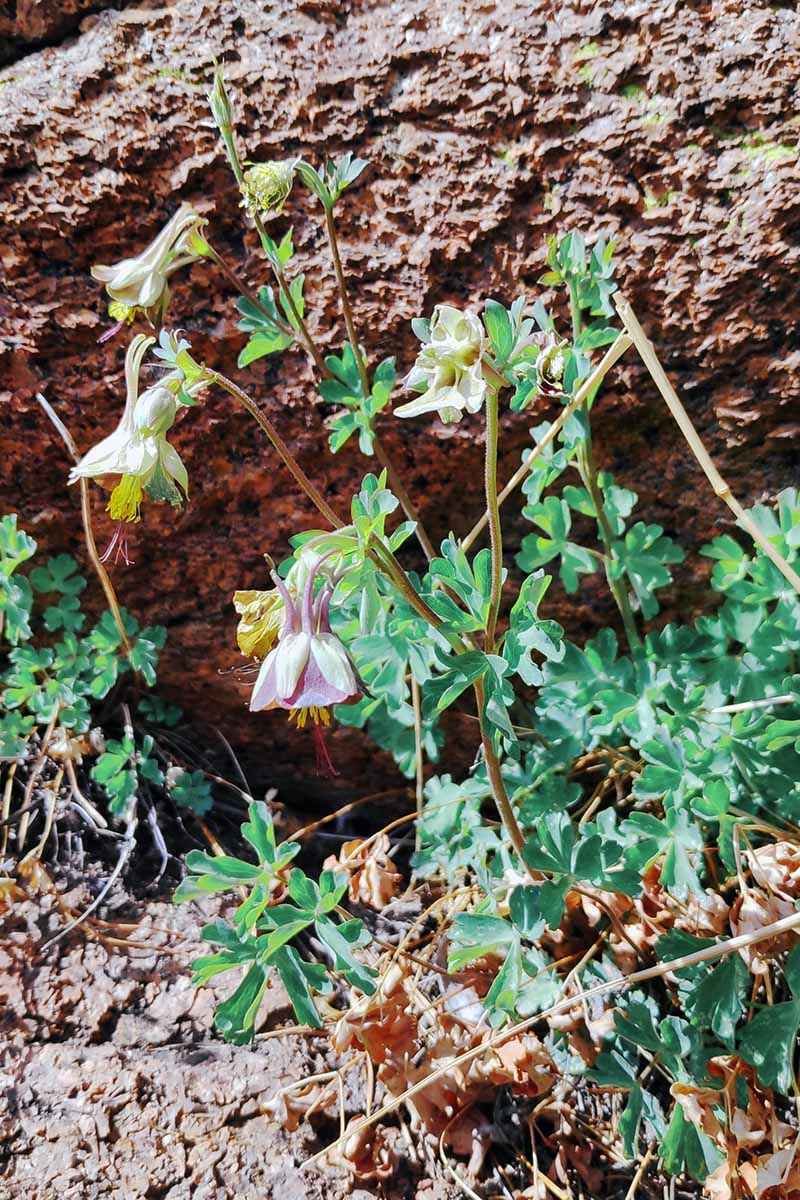
The leaves are green with a grayish cast. They are compound, consisting of three separate leaflets, and remind me a little of Italian flat-leaf parsley or a cranesbill geranium.
The flowers are fragrant and have nodding heads. They have five light green to greenish-yellow tepals, a center corolla of brownish-purple petals, and curled nectar-filled spurs.
Each bicolor flower measures approximately three-quarters of an inch long.
In Latin, Aquilegia means eagle and this refers to the sepals, which are thought to resemble talons. Viridiflora means green-flowered, so we have the green-flowered eagle.
Aquilegia is Native to Asia, Europe, and North America. The results of DNA studies indicate that the genus originated between 6.18 and 6.57 million years ago.
Scientists believe two different lineages originated in Siberia in the Pliocene Age.

One is likely the result of crossing Asian species with European ones. The other seems to have originated when North American and Asian species crossed.
A. viridiflora likely entered North America from northeastern Asia through Beringia, aka the Bering Land Bridge that joined Russia and Alaska.
Contrary to popular belief, “chocolate soldier” is not a cultivated variety of wild green columbine, but a descriptive nickname for the unadulterated wild species.
Propagation
Columbine is grown from seed and transplanted nursery starts. Division is not a good idea, as the plants are fragile and short-lived.
Here’s how to start a plant of your own.
From Seed
Unlike many of today’s cultivated hybrids, true species A. viridiflora produces seeds that exactly replicate the traits of the parent plant. However, cross-pollination is likely if it is planted near to other columbine cultivars.
If you already have a green columbine, you can harvest the tiny seeds from the dry brown pods that form after blooming.
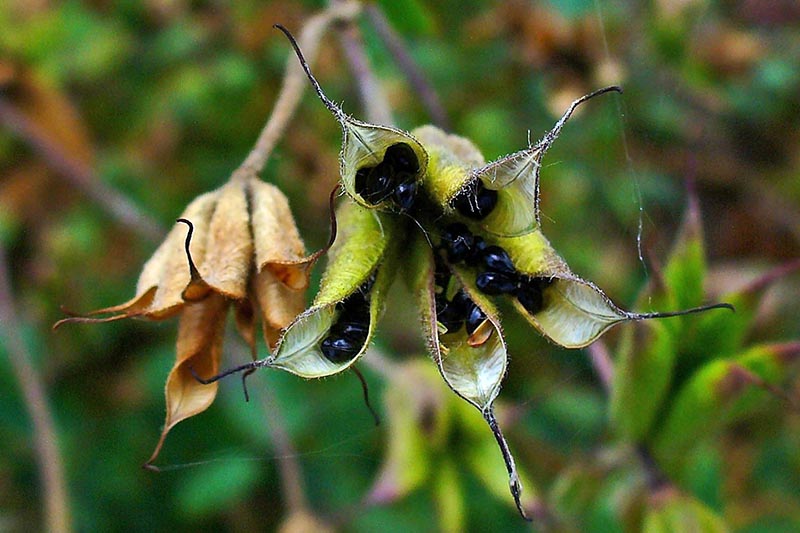
Alternatively, you can purchase seeds per the recommendation in the “Where to Buy section” below, or from another reputable purveyor.
Columbine seeds need to experience cold to stimulate spring blooming. This is achieved by chilling them before planting, a process called cold stratification.
Without chilling, plants grow leaves the first year and flower in the second.
Here’s how to sow seeds:
Fill the cells of a seed tray with potting soil and moisten it.
Sprinkle two to three seeds per cell and lightly press them onto the soil to anchor them.
Place the tray into a 40°F refrigerator for four weeks. Keep the soil moist during this period.
At the end of the month, place the tray on a warming mat to keep the soil at 70°F. Put the warming mat in a sunny indoor location.
Alternatively, you can use a grow light for 15 hours each day to simulate sunlight.
Keep the soil evenly moist but not soggy. It may take a month for the seedlings to sprout.
When they have one set of true leaves, thin them to one per cell.
When the seedlings are three to four weeks old, fertilize them with a half-strength liquid houseplant food per package instructions.
Once the danger of frost has passed, harden the seedlings off by placing them outdoors in a sheltered area every day for one week. Start with one hour of exposure and increase by one hour each day.
Once they have hardened off, you can transplant them to the garden.
Alternatively, you can direct sow seeds after the danger of spring frost has passed. Spring-planted seeds bloom the following year, like a biennial.
You can also sow seeds in the fall or early winter, provided the ground is thawed and prepared per the instructions below. By planting in this way, the seeds will have a chilling period and bloom in the same year.
From Seedlings/Transplanting
To transplant seedlings or nursery starts to the garden, first prepare the soil. Columbine prefers organically rich loam, but tolerates average soil quite well, provided it drains well. The ideal pH is 6.8 to 7.2.
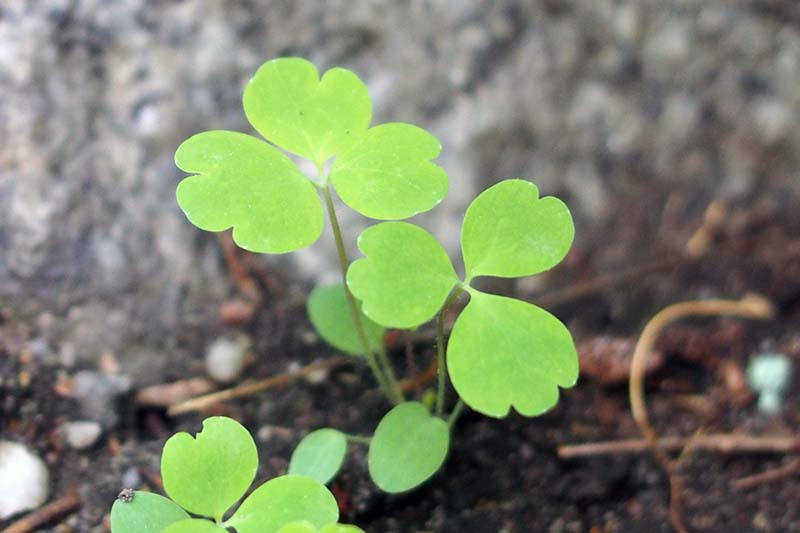
Do a soil test to determine your soil’s composition, or add a few handfuls of compost or humus to enrich it.
Carefully unpot the fragile seedlings or nursery starts from their pots and set them into the prepared soil at the same depth they were in their original containers.
Be sure to leave nine to 12 inches between the seedlings for adequate air circulation.
Tamp the soil firmly around them and water well.
How to Grow
Once planted, it’s vital to maintain even moisture. If it hasn’t rained during the week, moisten the soil to avoid letting it completely dry out.
Avoid getting the leaves wet. Instead, water the soil over the root zone.
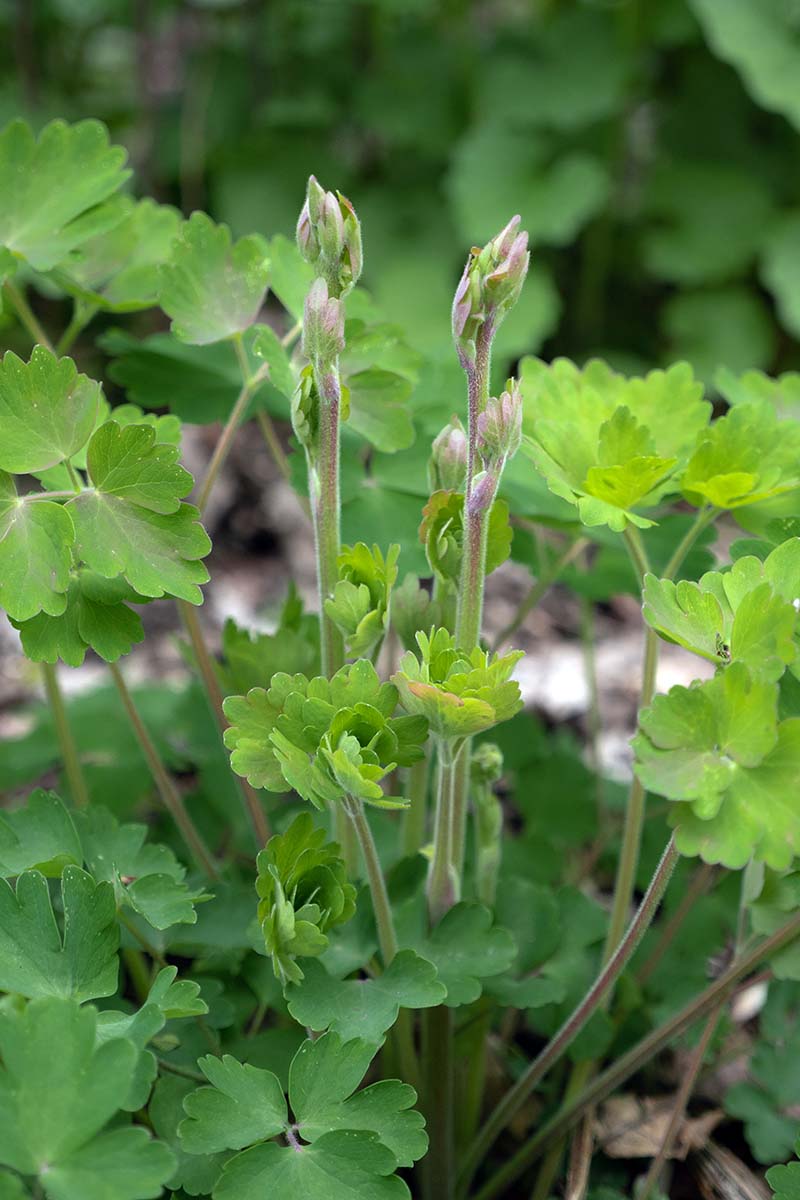
Every spring, provide a nutrient boost by spreading an inch of compost around but not touching the new shoots.
Deadhead spent flowers during the growing season to keep your plants looking their best, inhibit seed dispersal, and boost vegetative growth.
To grow in a container, choose a vessel that can accommodate the mature nine- to 12-inch width, and that has a depth of 10 to 12 inches to accommodate the taproot.
Fill it with a good-quality potting medium that is organically rich, well-draining, and moisture-retentive.
Use a moisture meter to monitor water needs. Maintain even moisture and avoid letting the pot dry out.
Growing Tips
Growing columbine is not hard when you remember the following:
- For flowers that bloom in the same year they’re planted, refrigerate the seeds first, or direct sow in the fall or early winter.
- Fertilize seedlings once during their development with half-strength houseplant food per package instructions.
- Choose a location with full sun to part shade.
- Provide organically rich soil that is slightly acidic to slightly alkaline and drains well.
- Maintain even moisture.
Maintenance
Once underway, columbine rewards with abundant blooms as the landscape wakes up from a long, cold winter. And then, all of a sudden, they are finished.
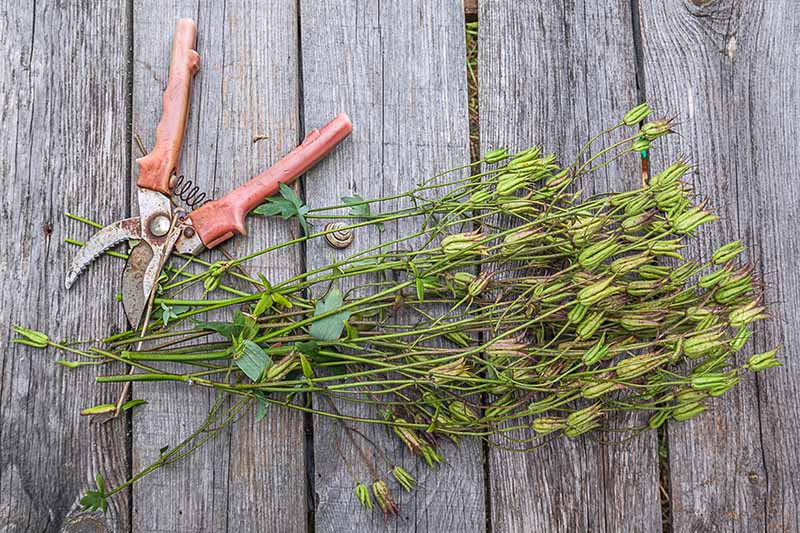
If you’ve been deadheading and find there are no more buds or blooms, it’s time to cut all of the stems down to the ground. Take care not to pull up the roots, and deposit all debris on the compost heap.
If you have not deadheaded, you’ll see that where there were flowers, now there are tulip-like brown pods. Each is full of tiny, dry, black seeds that you can collect.
Tip the pods and catch the seeds in a small jar or bag. Save them in a cool, dry place until fall planting time.
After you clear the season’s foliage, place a two-inch layer of mulch over the root zones of your plants for insulation against summer heat and winter cold.
In the spring, before adding compost, remove the mulch layer.
Now let’s look at a source for seeds.
Where to Buy
When shopping for A. viridiflora, you will likely find it listed as Aquilegia chocolate soldier.
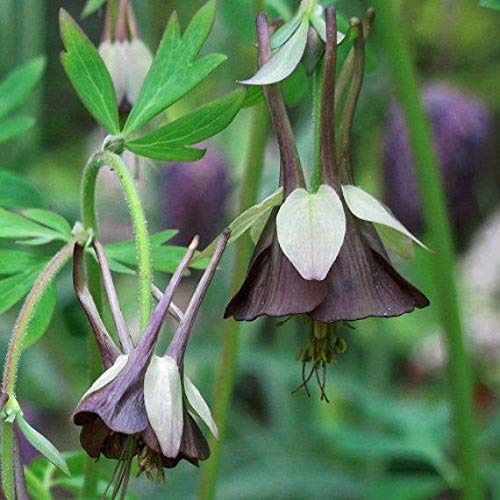
At a petite nine to 12 inches tall, the darkness of the brown corollas of Aquilegia chocolate soldier helps make the blossoms pop from the light green sepals and grayish-green foliage around them.
Chocolate soldier seeds are available from Dichondra via Amazon in packages of 25.
In addition to A. viridiflora, the green columbine species, there are cultivated varieties of other Aquilegia species that are green.
An example is A. vulgaris var. stellata ‘Green Apples.’ Unlike the nodding head of A. viridiflora, it has an upturned face. And instead of tepals and spurs, it has a fully double row of petals, more like a cornflower.
During the growing season, this flower shades subtly to white and achieves heights of 18 to 32 inches.
As new cultivars become available, the columbine color palette is likely to include more green options.
Managing Pests and Disease
You aren’t likely to have issues with pests, as it’s early in the season, but one to watch out for is the columbine leaf miner, Phytomyza miniscula.

Telltale signs of the leaf miner are small flies and the white trails their larvae make when they tunnel through the leaves. In addition to columbine, the aster also plays host to this pest.
The pros at the NC State Extension recommend treating infestations with a product containing imidacloprid, an insecticide that you can also use in the spring as a preventative soil drench.

BONIDE® Systemic Houseplant Insect Control
You can find imidacloprid in Bonide® Systemic Houseplant Insect Control, which is available from Bonide® via Amazon in an eight-ounce package.
This product consists of odorless granules that are applied to the soil, watered in, and taken up by the roots to eradicate or deter pests.
As for diseases, the one to be aware of is powdery mildew. It is a fungal condition that may rear its ugly head when plants are too close, the growing environment is too wet, or there is little light.
Symptomatic plants have foliage that appears to be covered in white or gray fuzzy blemishes before it dries up and drops off.
Preventative measures include the proper spacing of plants, good drainage, avoiding water on the leaves, and not planting in dense shade.
Treat affected plants with a sulfur-containing fungicide, like BONIDE® Sulfur Plant Fungicide. It’s available from Arbico Organics in a one-pound bottle or four-pound bag.
BONIDE® Sulfur Plant Fungicide
Treat active infections per package instructions. You have the option to dust plants with dry powder or mix the powder with water for sprayer application.
Best Uses
When a flower is primarily green, choosing an appropriate placement is crucial to getting noticed.
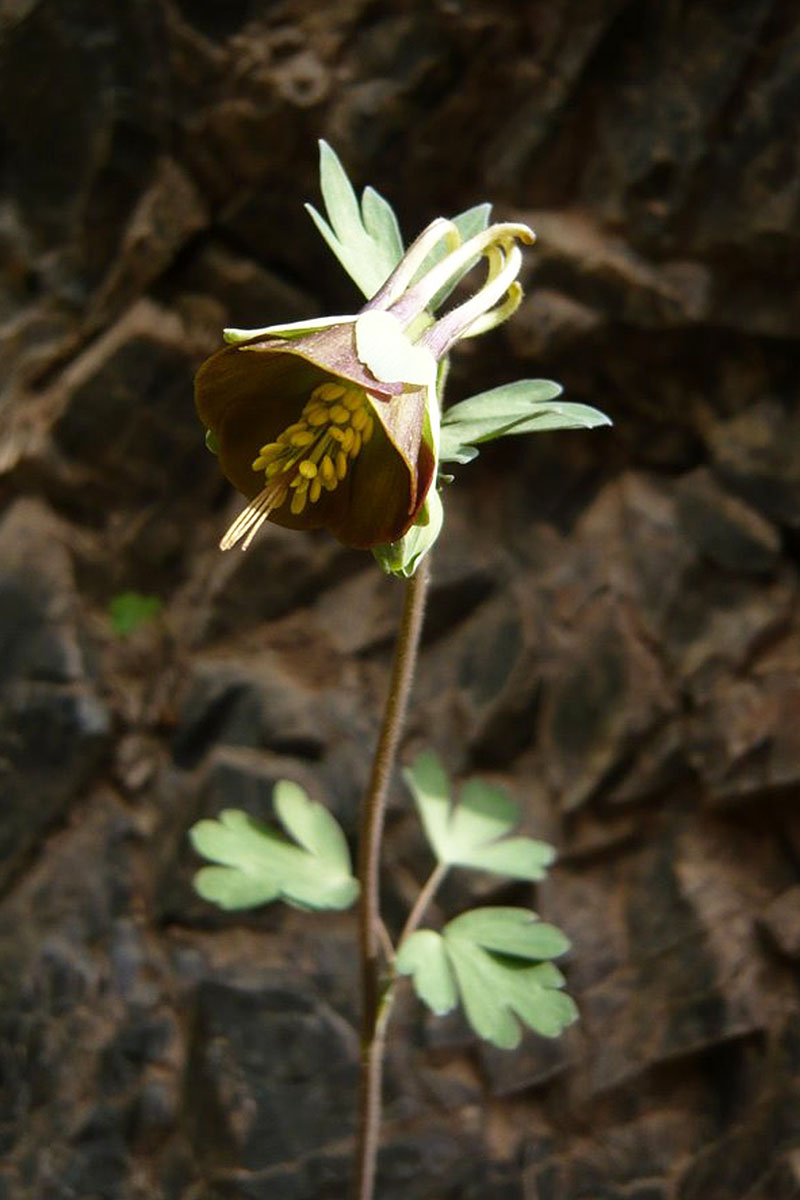
A sunny rather than partially shaded location helps shed light on the blooms and make them more visible.
Planting in a container or raised bed that brings blooms closer to a viewer’s eye also goes a long way toward showcasing their charming nodding heads.
And finally, a rock garden sets them off to great advantage when they can rise above the subtle backdrop of muted browns and grays, and afford viewers an unobstructed view.
Quick Reference Growing Guide
| Plant Type: | Herbaceous flowering perennial | Flower / Foliage Color: | Green to yellow-green and brownish-purple/gray-green |
| Native to: | China, Japan, Siberia | Maintenance: | Moderate |
| Hardiness (USDA Zone): | 3-9 | Tolerance: | Average soil, deer, drought once established, rabbits |
| Bloom Time / Season: | Spring to summer | Soil Type: | Organically rich loam |
| Exposure: | Full sun to part shade | Soil pH: | 6.8-7.2 |
| Spacing: | 9-12 inches | Soil Drainage: | Well-draining |
| Planting Depth: | Soil surface (seeds), same depth as container (seedlings/transplants) | Attracts: | Bumblebees, butterflies, hummingbirds |
| Height: | 9-12 inches | Uses: | Containers, raised beds, rock gardens |
| Spread: | 9-12 inches | Family: | Ranunculaceae |
| Water Needs: | Moderate | Genus: | Aquilegia |
| Common Pests and Diseases: | Leaf miners and powdery mildew | Species: | Viridiflora |
A Star Attraction
Unlike brighter and larger species and cultivars, green columbine, A. viridiflora, requires the casual observer to work harder to detect its presence in the garden.

A flower that’s not showy relies upon other charms to get noticed, such as a sweetly nodding head and petite features.
What’s the best way to give it the attention it deserves?
Remove all distractions by framing its location with a container, raised bed, or rocks in a location where the sun sheds light on it.
Without competition from other, brighter plants and their green foliage, your little chocolate soldiers are sure to steal the show.
Do you grow this plant? Tell us about it in the comments section below.
If you enjoyed reading about green columbine, here are more articles on flowers in shades of green that you may like to grow:

